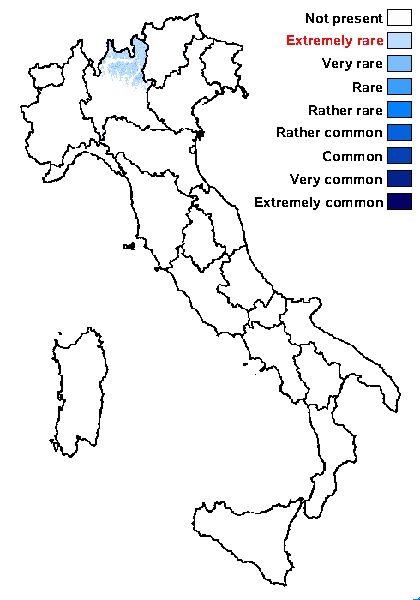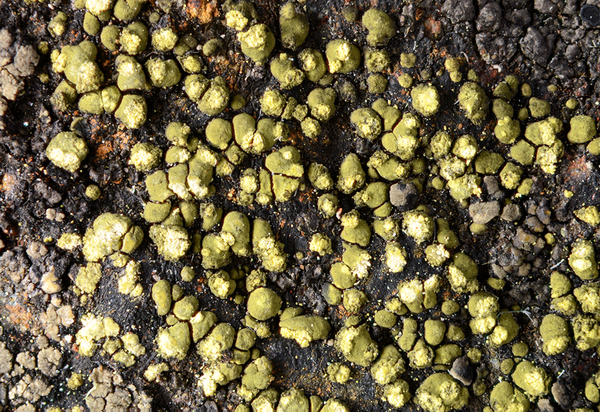Rhizocarpon sorediosum Runemark
Opera Bot., 2: 135, 1956.
Synonyms:
Distribution: N - Lomb.
Description: Thallus crustose, episubstratic, dirty yellowish green to grey green, areolate, sorediate, forming 1-3 cm wide patches, often delimited by a thin black prothallus, the areoles contiguous, 0.3-1(-1.2) mm wide, 0.4-0.8 mm thick, rounded to weakly angular, flat to weakly convex, smooth, each one with one or two, 0.1-0.4 mm wide maculiform soralia, the individual soredia 30-50 µm in diam. Cortex 20-30 µm thick, poorly differentiated; medulla white, I+ intensely blue. Apothecia extremely rare, lecideine, black, 0.5-1.5 mm across, more or less round, with a flat to convex disc and a finally often excluded proper margin. Asci 8-spored, clavate, fissitunicate, with a well-developed tholus that is K/I- in lower part and K/I+ blue near the apex, lacking an ocular chamber, Rhizocarpon-type. Ascospores weakly muriform, brown, ellipsoid, often poorly developed, c. 20 x 11 µm, halonate at least whyen young. Photobiont chlorococcoid. Spot tests: medulla K-, C-, KC-, P- or P+ yellow. Chemistry: cortex with rhizocarpic acid; medulla with barbatic and/or psoromic acid.Note: on heavy metals-bearing siliceous rocks in upland areas; probably overlooked, being almost always sterile; closely related to Rh. ridescens.
Growth form: Crustose
Substrata: rocks
Photobiont: green algae other than Trentepohlia
Reproductive strategy: mainly asexual, by soredia, or soredia-like structures (e.g. blastidia)
Species of metal-rich rocks
Commonnes-rarity: (info)
Alpine belt: extremely rare
Subalpine belt: very rare
Oromediterranean belt: absent
Montane belt: extremely rare
Submediterranean belt: absent
Padanian area: absent
Humid submediterranean belt: absent
Humid mediterranean belt: absent
Dry mediterranean belt: absent

Predictive model
Growth form: Crustose
Substrata: rocks
Photobiont: green algae other than Trentepohlia
Reproductive strategy: mainly asexual, by soredia, or soredia-like structures (e.g. blastidia)
Species of metal-rich rocks
Commonnes-rarity: (info)
Alpine belt: extremely rare
Subalpine belt: very rare
Oromediterranean belt: absent
Montane belt: extremely rare
Submediterranean belt: absent
Padanian area: absent
Humid submediterranean belt: absent
Humid mediterranean belt: absent
Dry mediterranean belt: absent

Predictive model
 INDEX FUNGORUM
INDEX FUNGORUM
 GBIF
GBIF


